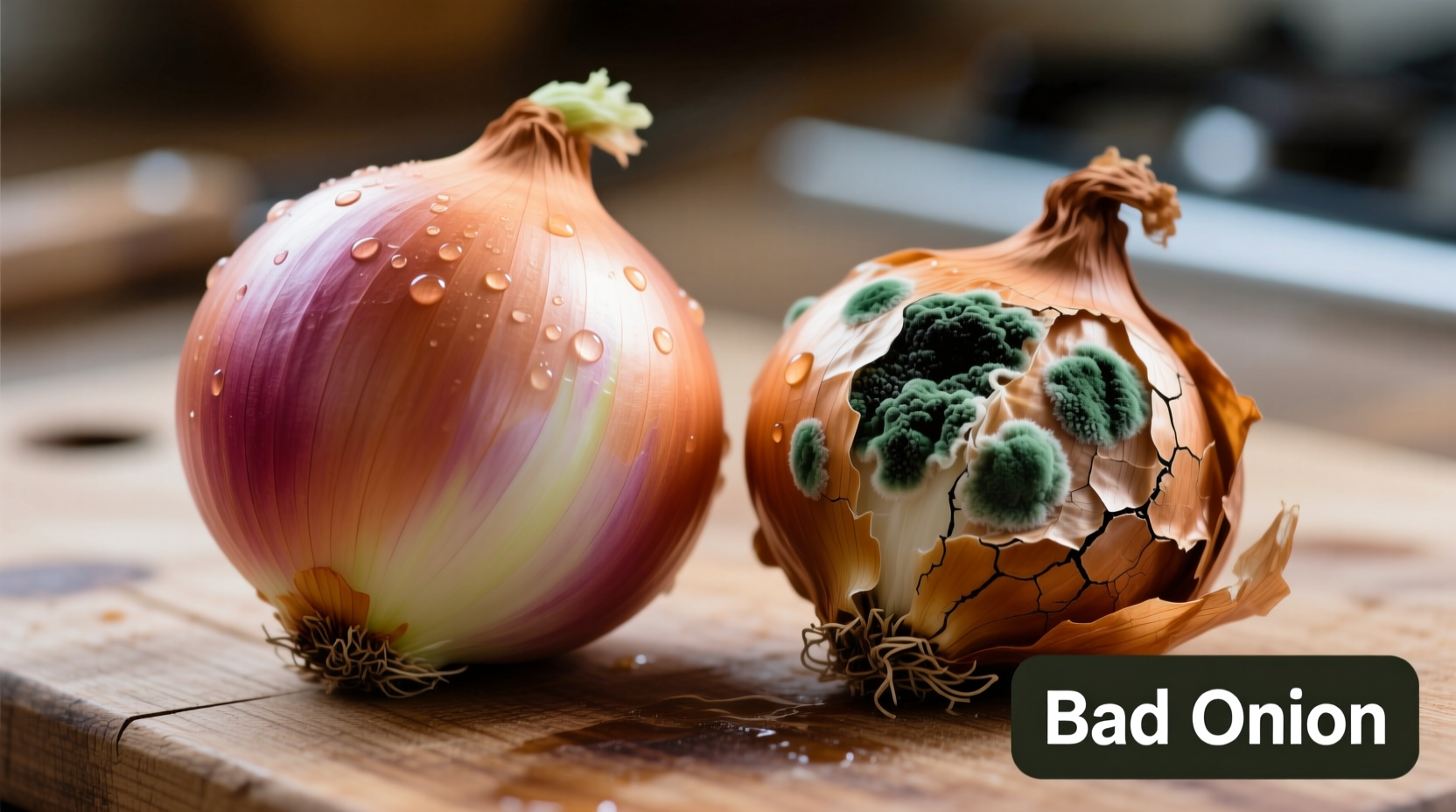If your onion has soft spots, mold growth, a slimy texture, or emits a sour or rotten smell, it's bad and should be discarded immediately. Fresh onions should feel firm, have dry papery skin, and show no signs of decay or unusual odors.
Ever pulled an onion from your pantry only to wonder how to tell if onion is bad? You're not alone. Each year, American households waste nearly 130 billion pounds of food, with vegetables like onions contributing significantly to this loss. Knowing exactly when to toss an onion saves money, reduces waste, and prevents potential foodborne illness.
Visual Inspection: What Bad Onions Look Like
Before touching your onion, perform a visual check. Healthy onions have tight, dry, papery outer skins that feel crisp to the touch. When identifying spoiled onions by appearance, watch for these critical warning signs:
- Mold growth - Any fuzzy white, green, or black spots indicate advanced spoilage
- Dark patches - Brown or black areas that weren't present when purchased
- Excessive sprouting - While small sprouts might be acceptable, long green shoots signal aging
- Wet spots - Any areas that appear moist through the skin
| Good Onion Characteristics | Bad Onion Warning Signs |
|---|---|
| Dry, papery outer skin | Moist or slimy outer layer |
| Firm to the touch | Soft spots or mushy areas |
| Uniform color | Dark patches or discoloration |
| No visible sprouts | Long green sprouts emerging |
Tactile Assessment: Feeling for Freshness
After visual inspection, gently squeeze the onion. Proper onion freshness testing techniques involve checking for firmness throughout. A fresh onion should feel solid with no give when pressed. If you detect any of these issues, discard the onion:
- Soft or mushy spots anywhere on the bulb
- Excessive weight loss (shriveling)
- Wet or slimy texture on the surface
- Loose or separating layers
According to the FDA Food Code, onions showing significant softening have likely developed bacterial growth that can't be seen with the naked eye.
The Smell Test: Detecting Spoilage Through Odor
Your nose is one of the most reliable tools for determining if an onion has gone bad. While fresh onions have that characteristic sharp, slightly sweet aroma, spoiled onions emit distinctly unpleasant odors:
- Sour or vinegar-like smell
- Rotten or sewage-like odor
- Musty or moldy scent
- Complete absence of onion smell (indicates advanced decay)
Don't be fooled by the initial pungency of onions—focus on whether the smell turns unpleasant after the initial sharpness fades. Trust your instincts; if something smells "off," it probably is.

Internal Examination: What Happens When You Cut It Open
Sometimes spoilage starts from the inside. If your onion passes the initial tests but still seems questionable, cut it in half. A fresh onion should have crisp, white to pale yellow layers with no discoloration. Watch for these internal warning signs:
- Brown, black, or gray spots within the layers
- Slime between the layers
- Unusual softness when pressed
- Cloudy liquid oozing from cut surfaces
The USDA National Institute of Food and Agriculture notes that internal discoloration often indicates bacterial growth that can spread throughout the onion even if surface appearance seems normal.
Onion Spoilage Timeline: How Quickly Do Onions Go Bad?
Understanding the natural progression of onion spoilage helps identify problems early. Here's what happens as onions deteriorate:
- Days 1-7: Optimal freshness with firm texture and strong aroma
- Days 8-14: Outer skin may begin drying excessively; slight softening may occur
- Days 15-21: Visible soft spots develop; sprouting may begin
- Days 22-28: Significant softening, mold growth, and unpleasant odors emerge
- Day 29+: Advanced spoilage with slime, discoloration, and potential bacterial contamination
Proper storage significantly extends this timeline. Whole, unpeeled onions stored in a cool, dark, well-ventilated area typically last 2-3 months, while refrigerated cut onions remain fresh for 7-10 days.
Storage Solutions to Maximize Onion Freshness
Preventing spoilage is better than detecting it. Follow these professional onion storage techniques to extend shelf life:
- Store whole onions in a cool, dark, dry place with good air circulation
- Never store onions in plastic bags—they need to breathe
- Keep away from potatoes, which emit moisture and gases that accelerate spoilage
- Refrigerate only after cutting, and store in an airtight container
- Never store onions near heat sources like stoves or dishwashers
Cornell University's Food Science Department research shows that onions stored at 45-55°F (7-13°C) with 65-70% humidity maintain optimal freshness longest. Room temperature storage works well for most homes, but avoid warm kitchens during summer months.
Safety First: When to Definitely Discard an Onion
When assessing onion safety for consumption, follow these clear guidelines:
- Discard immediately if mold is visible anywhere on the onion
- Throw out onions with slimy texture or liquid seepage
- Never consume onions with sour or rotten odors
- Discard if more than 25% shows signs of spoilage (cutting away bad parts isn't safe)
The FDA emphasizes that mold on onions can produce mycotoxins that penetrate beyond visible areas. Unlike some fruits and vegetables, you cannot safely cut away spoiled portions of onions.
Common Questions About Onion Freshness
Here are answers to frequently asked questions about determining onion quality and safety:











 浙公网安备
33010002000092号
浙公网安备
33010002000092号 浙B2-20120091-4
浙B2-20120091-4